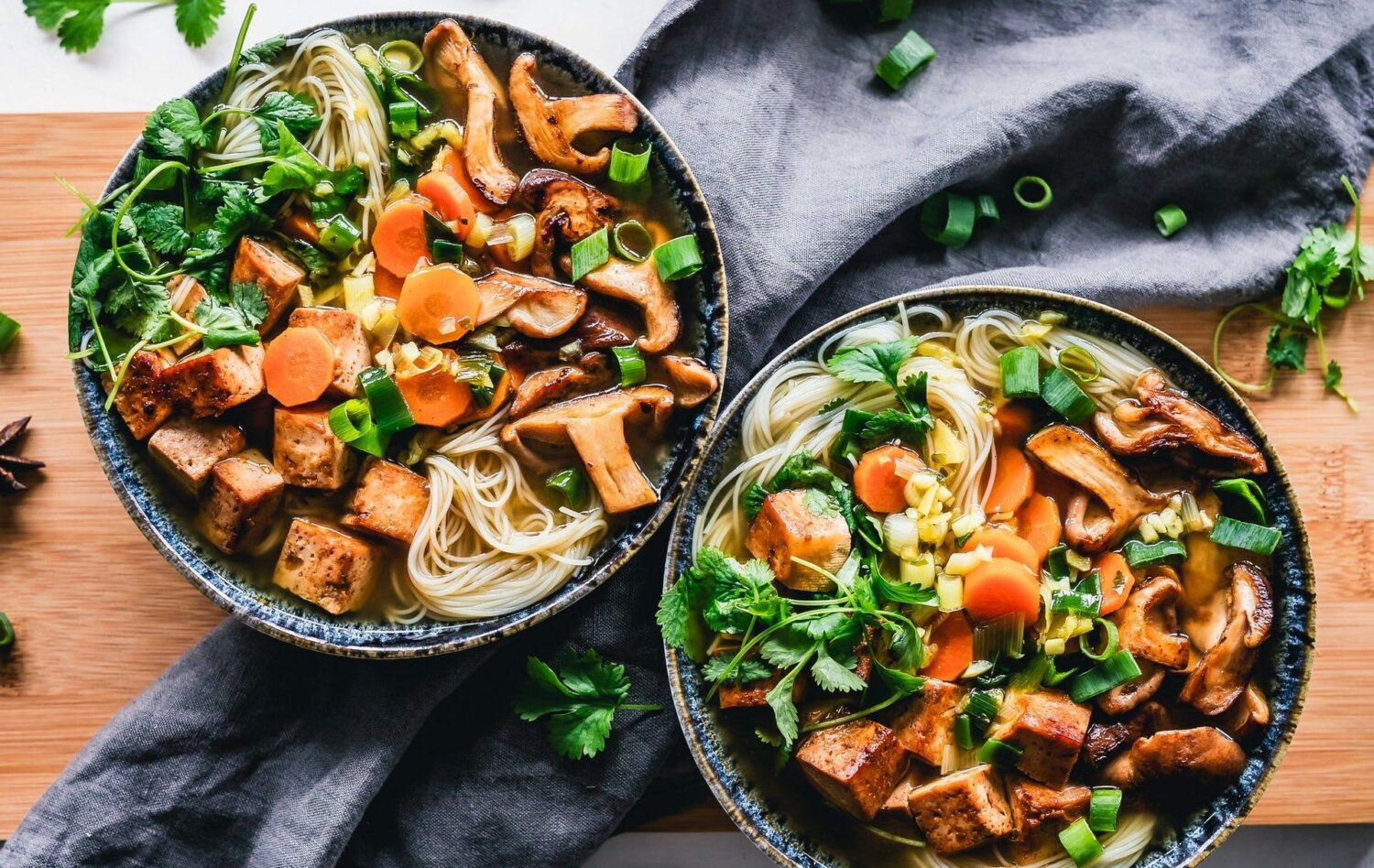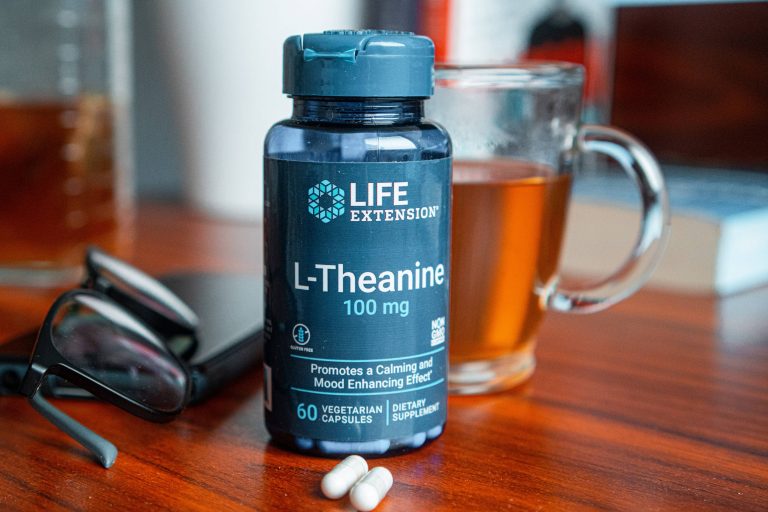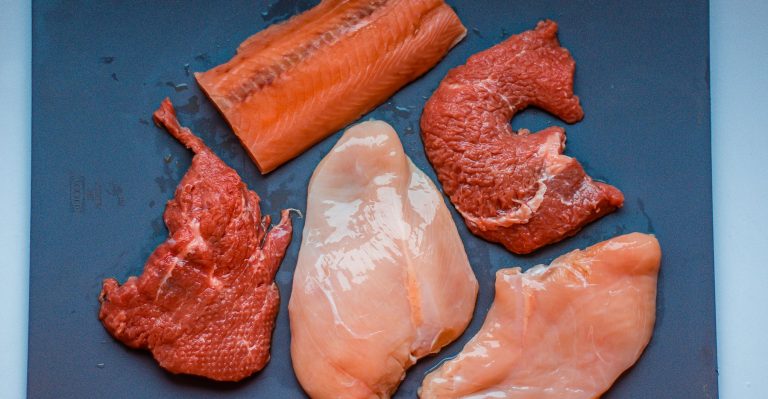The Macrobiotic Diet Introduction: Foods, Benefits and Basics
Macrobiotic Diet
The macrobiotic diet is a Buddhist dietary approach to balance Yin and Yang energy.
It is more of a lifestyle change that emphasizes a special way of cooking, preparing, and chewing the food, along with the active lifestyle and types of foods we choose.
The macrobiotic diet has become so famous for its health benefits, versatility, and authenticity. It is believed that many Buddhists eat this way since it aligns with many of their principles. It is the type of diet you would expect a yogi to follow.
Similar to a Vegan diet, but not as restrictive and a lot more mindfulness-focused. The way you chew, prepare, and mix the food along with the foods you eat will change after reading this.
Origin & Concept
This Macrobiotic diet is founded & created by George Oshawa a Japanese philosopher.
George defined health as good appetite & sleep, great memory & humor, the precision of thought and action, high energy or lack of fatigue, and gratitude.
He is a famous author, who wrote many books in both Japanese and French languages. Famous for its views and perspectives on health and well-being, he wrote some of the best books on dieting. His teachings took place in the 1930s when he was at his peak, spreading around the USA in the sixties.
This means that on the same caloric content you can get less or more vitamins, which is known. But also, on the same caloric content by the way you prepare food you can get more or less energy. Aside from energy quantity, the way you feel, refreshed and energized or relaxed has a lot to do with your food choices and their temperature.
Compared to vegan or high-fiber foods, there are slight differences that make this Macrobiotic diet very authentic and versatile.
Macrobiotic lifestyle
Contrary to popular belief, this diet is not restrictive in terms of:
- Macronutrient ratio
- Calorie intake
The Macrobiotic is so Zen that even the foods you choose are more of a staple and example rather than a complete restriction.
Let me clear it up for you:
- In a Vegan diet, you should totally avoid animal products
- In the Carnivore diet, you should totally avoid plant-based products
- In a Ketogenic diet, you should have a certain macronutrient ratio
- In an Alkaline diet, you should exclude acidic, processed foods
This Macrobiotic diet gives guidance, but not restrictive rules. For example, most of the foods you eat are plant-based, but you might as well include some fish. You should not consume dairy products, but you may have some hard cheese or eggs here and there. You shouldn’t use too many sauces, but you can season your plate with different herbs.
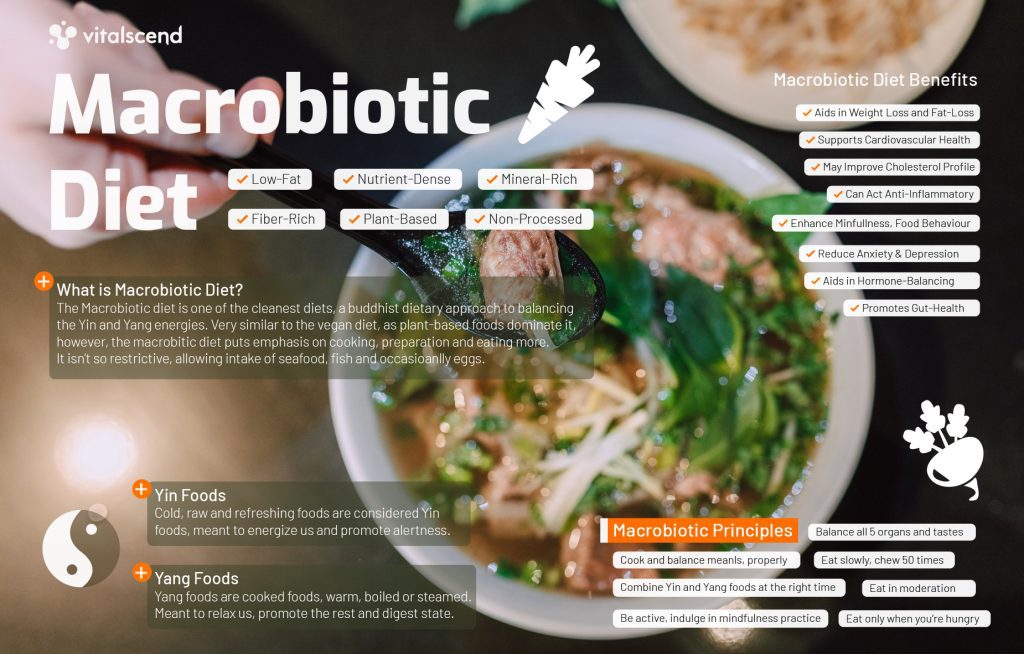
Macrobiotic Rules
So everything in this Macrobiotic diet goes around lifestyle choices, moderation, and high-quality food.
Here are a couple of directions, and rules of guidance for this Macrobiotic style:
- Eat only when you are hungry – learn not to confuse emotions with hunger
- Eat slowly, chew 50 times each bite – to not dismiss the satiety and fullness from your stomach
- Eat mindfully, don’t watch TV – mindful eating allows us to really enjoy the foods, taste them, and extract all the nutrients, feel them deeper and sharper.
- Cook properly – this means balancing between steamed, raw food (yin) and fried (yang)
- Combine good – combine yin foods (greens, soy) with yang foods (chocolate, coffee)
- Organ balance – include and balance all 5 tastes, associated with different organs
- Be active – low-intensity, all-around activity is crucial for regenerating your energy
- Mental balance – indulge in practice such as breathing, meditation yoga, or visualization
- Eat-in moderation – never overeat or under-eat
Yin & Yang
Since one of the main purposes of this diet is to balance the Yin & Yang energies, it’s good to know what they are.
Yin and Yang come from ancient Chinese philosophy, one of the most popular concepts of all time. The Yin-Yang logo is a circle with half black and half white parts, in each, there is an opposite-colored dot. You may have heard that life consists of good and evil, but in good, there’s evil (white with a black dot) and in evil, there is good (black with a white dot).
The best way to present this concept of dualism is by its opposite or contrary forces which are complementary, meaning one doesn’t exist without the other. There is not just one side, white or feminine or north. As there is the north, there is south, as there is white, there is black, as there is masculine, there is feminine.
How does the Macrobiotic diet imply Yin-Yang philosophy?
You can see Macrobiotic dieting as Yin-Yang nutrition. In fact, everything that comes from this yin-yang in nutrition is included in this specific diet, since that is its sole purpose.
Macrobiotic diet views food as yin and yang, those that are refreshing, and those thatare relaxing.
- It separates raw and steamed foods from grilled and fried, yin, and yang.
- It separates food tastes into sour, sweet, salty, bitter, and pungent including the 6th Japanese, which is umami which means deliciousness.
- It categorizes the foods into yin and yang, the difference between greens, legumes, coffee, chocolate & eat.
In the Macrobiotic style, Yin is seen as refreshment, energy, and activity, and yang is seen as relaxation, digestion, warmth, and sleepiness. Too high, extreme measures of yin and yang are not good and should be balanced.
- The goal of this diet is to eat a well-balanced diet, and foods or ways of cooking that are on the edge of being too yin or to yang are excluded or avoided.
- For example, deep frying and hard frying food is extremely or highly yang, so should be avoided.
- Another example, raw veggies such as leafy greens are too yin and should be cooked, and steamed.
- Excluding all animal protein will cause malnutrition, so the addition of fish, eggs, and hard cheese is allowed.
Cooking and Eating
There are a couple of directions when it comes to food preparation.
First of all, the best thing about this diet is eating locally grown foods, at their seasonal peak. This means you would choose seasonal fruits and veggies, and eat them by their climate regime of growth.
You pick up clean, organic, non-GMO, gluten-free food most of the time and you avoid processed food, refined sugars, and red meats.
You have a wide variety of options when it comes to food, including fresh fruits and vegetables, nuts and seeds, beans and legumes with occasional eggs, fish, seafood, and herbs.
When cooking, there is a whole philosophy behind the art of Macrobiotic cooking.
They classify food into:
Cold- Fresh- Neutral- Warm- Hot
The colder the food, the more Yin it is. The hotter the food, the more Yang it is.
Even though the basic principle is balance, most Yin foods are morning friendly, to wake you up, make you alert and energized for the day while Yang foods are those that produce a rest and digest state, can get you to sleep faster, and regenerate.
Another rule is that you don’t throw vegetable parts, but clean them up and add them to a soup or side dish. You eat the whole plant.
When it comes to cooking, you have a couple of options:
Raw- Steamed- Poached- Boiled- Grilled- Smoked- Fried
Usually, the more a plant is raw, the more Yin it is. The more it is cooked, the warmer it is, and the more Yang it is. Since we aim for some balance, over-the-edge cooking practice or temperatures such as raw and frozen from Yin and too hot and deep-fried from Yang is what we try to minimize, exclude or avoid.
Eating practices in the Macrobiotic diet are more focused on mindfulness, real hunger, food enjoyment, non-distracted eating, chewing good and sharper senses.
The food you eat should be made with love and eaten with love as well. You should completely indulge in the activity of eating If you want to really taste, absorb, and extract the abundance of nutrients your food contains.
The macrobiotic diet is not just about the food choices, but a big part of it is the way of eating and preparing the food, along with the right balance and high-quality food choices.
The reason why you would want to eat only when hungry and eat slowly and mindfully is to feel the satiety-promoting effects of food and know when you are done. People who eat mindlessly do not taste the food they eat, so they always have some appetite that goes along. They do not get the satiety effect on time, because they eat so fast which makes it easier to overeat.
Taste & Organs
In the Macrobiotic diet, different types of taste affect different organs.
Specific foods have an effect on specific organs. When we are talking about a diet or food in relation to organ health, it is not just about supporting organ function but also the hormones secreted by the glands next to the organ.
This diet balances the yin-yang forces, but this also means it balances hormones. The thing is to get the right amount of stress and relaxation. Very stressed people ride on cortisol and adrenaline all day and can’t get a good night’s sleep.
| Taste | Association |
| Sour-tasting citrus fruits | associated with liver health, are known for water retention, and can help with diarrhea and sweating. |
| The sweet taste | is connected to the spleen and stomach – known as highly satisfying and mood-supportive foods. |
| A bitter taste | may increase appetite and it is associated with heart health |
| The pungent taste | is like chili but refreshing, something felt in your throat when eating ginger. |
| Salty foods | like meat and salt are associated with kidney health and should be consumed in moderation |
| Chilly and soury things | in refreshing and cold form, can wake us up, increase metabolism speed, and boost energy. |
| Warm, sweet, and sauce-textured foods | are known to get us into a rest and digest state, activate our parasympathetic system, and enable us to relax |
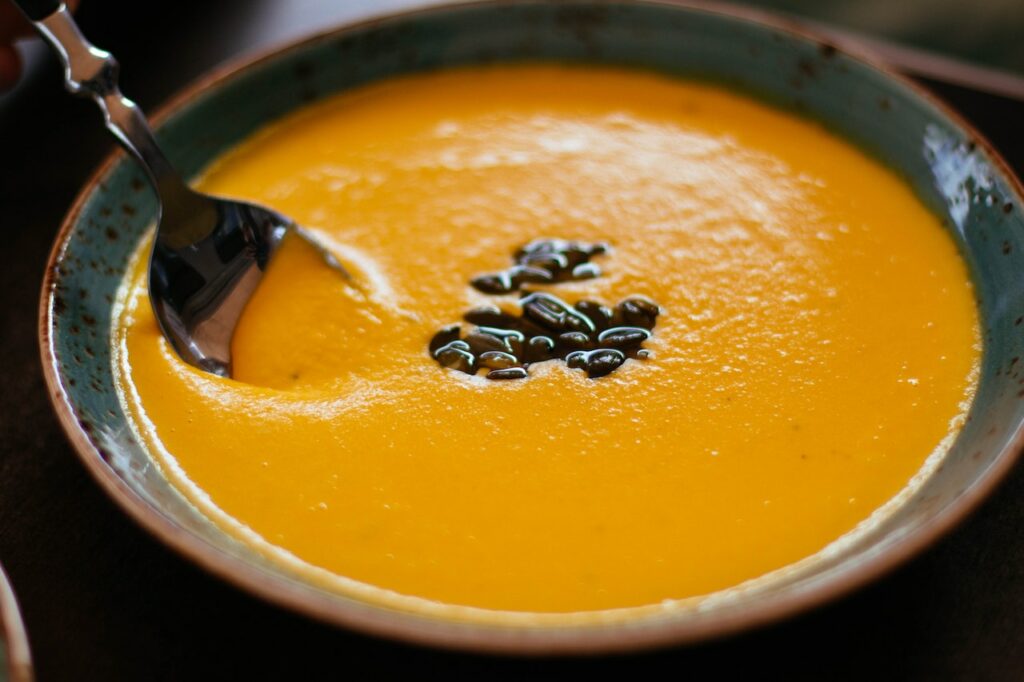
Macrobiotic Plate & Meals
Enough reading, let’s see some practical examples.
This is how your macrobiotic friendly plate should look like:
1. Miso soup, leeks, clams, noodles, seaweed, tofu, onion
2. Sweet potatoes, lentils, peas, black beans, and broccoli wild garlic
3. Black rice with broccoli lemon and poached salmon
4. Peas, sesame seeds, homemade pesto, and chickpeas
5. Crab with spinach, beetroot, sesame, oregano, and fava beans
6. Peach, strawberries with cashews, and dark chocolate
7. Lobster with onion, mushrooms, lemon, and garlic
8. Quinoa, corn, lemon, rye, basil, and poached salmon
9. Avocado, red kidney beans, spinach, and squid
10. Vegan bowl of chickpeas, red lentils, cauliflower, and curry
When you start with the Macrobiotic diet, there is no strict rule to follow.
The food choices you make, the cooking, the combination & balancing, and the mindful eating are the most important parts. However, there is something that can give you a basic idea and make it easier for you to fill a plate.
A casual Macrobiotic plate looks like this:
- 20-30% Green leafy or cruciferous vegetables (spinach, bok choy, romaine lettuce, cauliflower, broccoli)
- 20-30% Starchy veggies, whole grains (sweet potatoes, carrot, rye, parsnips, quinoa, acorn squash)
- 10%-20% Beans and legumes (lentils, peas, fava beans, red kidney beans of black/white beans)
- 10-20% Tofu, Nuts, or fruit (tofu, cashews, almonds, seeds, apricot, banana, pineapple, apple)
Macrobiotic Soups
Usually, those who eat Macrobiotic style, eat a lot of soups, poached seafood or fish, seaweed, and boiled veggies. The most practical and popular dishes in this diet are soups so here are a couple of soups:
- Mushroom Barley soup
- Miso soup with tofu, noodles, and leek
- Broccoli Cauliflower Soup
- Tomato, onion, and garlic soup with oregano
- Leek, shrimp, parsley, and potatoes soup
- Fakes, soup with onion, carrots, tomatoes, and garlic
- Asam Laksa, soup with rice noodles, fish, and sliced peppers
- Noodles, carrots, chickpeas, and basil soup
- Caldo de camaron, with shrimp, squash, carrots, broth, and avocado
Foods to Eat
While many think it is a pretty restrictive diet, in fact, the Macrobiotic diet only excludes processed food, refined sugars, red meats, pastry, and artificial sauces & sweeteners.
Basically, most of the vegan-friendly foods, excluding vegan junk foods, are friendly to eat when on the macrobiotic diet. In my opinion, macrobiotics are better since it allows eating seafood, eggs, and fish which will improve protein content as well as other essential nutrients like omega 3, leucine, and B vitamins.
Here is a list of food to eat on a Macrobiotic diet:
Pretty similar to the Vegan style of eating, here is a list of what this diet allows:
- Beans and Legumes: red kidney beans, lentils, peas, fava beans, black beans, chickpeas
- Whole grains and Wheat: Rye, Brown rice, white rice, Quinoa, Buckwheat, Noodles
- Green Leafy Vegetables: spinach, lettuce, collard greens, cabbage, arugula, bok choy
- Starchy veggies: sweet potatoes, yams, squash, corn, pumpkin
- Non-starchy veggies: asparagus, mushroom, broccoli, cauliflower, cucumbers, peppers
- Fruits: apricot, peach, banana, pineapple, grapes, watermelon, quince, apple, avocado
- Fish & Seafood: salmon, crab, lobster, octopus, tuna, trout, shrimps, abalone
- Nuts: cashews, almonds, walnuts, brazil nuts, peanuts, and pistachios
- Seeds: chia seeds, flax seeds, sesame seeds, pumpkin seeds, hemp seeds, and sunflower seed
- Healthy Oils: olive oil, coconut oil, walnut or avocado oil
- Edible Seaweed: wakame, nori, kombu, Umi budo, ogonori, hijiki
The diet itself is not too restrictive so you can have some other foods if you really crave them, but the staple of the diet is these foods.
It is more important to cook, combine, and eat properly, as discussed above.
Foods to Avoid
The foods you should exclude from the Macrobiotic diet are:
- Red Processed Meat: salami, sausage, bacon, hotdogs
- Lactose Dairy: Milk, Yogurt, Cheese
- Processed foods: granola, flavored nuts, dried fruit, protein bars, instant soup, margarine
- Refined Sugars & Pastry: sweets, cookies, croissants, cakes, desserts, candy
- Meat: chicken, turkey, duck meat, elk, bison, beef
Again, the macrobiotic diet isn’t as restrictive with food choices as it is with following the rules of proper cooking and mindful chewing so keep that in mind.
The bulk of your diet should include whole grains and vegetables, with the addition of nuts, seeds, fruits, fish, seafood, and eggs. You should skim any chemically processed, refined, toxic foods and go for whole foods.
Health Benefits of the Macrobiotic Diet
The macrobiotic diet offers a variety of health benefits, some of which are evidence-based, but most of which are claims or predictions.
Now you can go learn more about this diet by reading about the Vegan diet itself since most of the foods are pretty similar.
There is good research data on the main potential benefit of this diet which is to prevent or treat cancer, however long-term, large studies supporting this evidence strongly are not yet been found.
Here is a list of potential health benefits of eating Macrobiotic:
- Weight loss, lower-calorie per higher volume, nutrient-dense foods, and eating mindfully, plus eating only when hungry will surprise you how beneficial it can be in terms of weight loss.
- Self-awareness, yogic lifestyle, monk habits. This macrobiotic diet has a lot to do with a lifestyle change, ways of cooking, and eating which will make you more mindful.
- Depression & Anxiety, basically adopting a toxin-free, non-GMO, and processed food-free diet will impress you how fast your hormones can get balanced, improving cravings and increasing endorphins or good-feeling hormones.
- An anti-inflammatory diet, since you are excluding most processed meat and refined sugar, mostly cooking with low heat, boiling, poaching, or steaming you have already reduced most of the inflammatory factors.
- Nutrient-dense diet, since it includes highly nutritious whole grains, nuts & seeds as well as fruits, vegetables, seaweed, and some fish.
- Heart-Healthy, the macrobiotic diet being similar to the vegan diet, may improve cholesterol profile, cut cardiovascular disease risk, reduce hypertension, and more.
- Gut health & Mood, since the gut-brain axis exists, this diet can improve your mood by impacting your digestion and gut microbiome. Reducing the intake of processed food translates into a better mood and cognitive function since there’s lower inflammation.
- Hormone-Balancing, the main goal of the diet is to balance Yin-Yang energies. This will also affect hormonal balance since foods are cooked, combined, and eaten in a way that is gentle on your organs and glands.
Macrobiotic Diet & Cancer
The macrobiotic diet has been a very well-known practice, a comprehensive complementary healthy lifestyle and dietary approach to healing diseases, cutting the risk, or preventing cancer, and reducing inflammation. As a diet that excludes processed foods and has whole foods, and plant-based staples, this macrobiotic diet may improve overall vitality, energy, and longevity. (1)
Some of this has to do with reducing circulating levels of estrogen. A macrobiotic diet may reduce the risk of cancer, but we do need further research to hold a shred of strong evidence. However, reducing inflammation, and improving vitality and heart health can be a good enough reason to try it.
The macrobiotic diet indicated a potential for disease prevention, but the content of vitamin D, B12, and calcium in most of the studies was lower than usual. (2)
Potential Drawbacks & Negative Side Effects
Brain development
Linear growth
Weaker bones & Rickets
The data on this topic is infinite. In fact, many researchers have seen the correlation between diet low in B12, zinc, iron, and omega-3 such as vegan or macrobiotic diets, and brain development of children.
To make a strong conclusion, we need larger and longer studies, however, this review shows an association between diets low in those nutrients and hindered neurological development in children. (3)
In a study that included 243 participants from 0 to 10 years, they saw stagnation in linear growth associated with a macrobiotic diet. Total protein was associated with linear growth while energy intake was not. (4)
The finding also supported that children that added fatty fish and dairy products have grown rapidly to catch up for their stagnation. This leads us to understand that nutritional deficiencies may hinder children’s growth unless supplemented right.
There is another study that supports the growth of stagnation evidence. In fact, this diet can be low in vitamin D and zinc which can have a significant effect on bone development. The macrobiotic diet has high amounts of phytate and oxalate inhibitors which can hinder optimal zinc absorption. (5)
Who should avoid this diet?
The macrobiotic style of eating may not be the best option for pregnant women, infants, or children since it can hinder their development. This is why before choosing a diet such as vegetarian, macrobiotic, or vegan you must first learn about the consequences, ask for nutritional guidance from an expert and consult with your doctor.
Nutritional Deficiencies
A macrobiotic diet may cause nutritional deficiencies so smart supplementation is definitely required.
Avoiding meat and most animal products can make you run low on:
- Iron – oxygen transport through the blood, immune system, and cognitive function support
- Zinc – protein synthesis, testosterone production, DNA creation, and immune system support
- Vitamin D – Testosterone production, muscle growth, bone strength & development
- Vitamin B12 – supporting nerve function, the production of red blood cells, and DNA creation
- Calcium – formation, and maintenance of bones & teeth, muscle contractions, and nerve functioning
- Magnesium – enzyme co-factor, regulation of biochemical reactions, blood glucose & pressure regulator
conclusion
The macrobiotic diet is a popular Yin-Yang Balancing dieting plan that emphasizes a special way of cooking and eating food. It is far less restrictive in terms of food choice and macronutrients compared to other diets. Soup is the main type of meal served in the Macrobiotic diet, which is all about excluding overly processed foods. Characteristic foods for this diet are miso soup, noodles, vegetables, seafood, legumes, and herbs.
Frequently Asked Questions
What are the benefits of a macrobiotic diet?
Macrobiotic diet may aid in weight loss, reduce anxiety and depression, improve mindfulness and food behavior, reduce inflammation, provide tons of nutrients, support cardiovascular health, balance our hormones and promote gut health.
How is a macrobiotic diet related to Buddhism?
The main goal of macrobiotic diet is balancing the Yin and Yang energies. It does this by combining, preparing, eating, and balancing the fresh/cold foods which are considered Yang, and warm/boiled foods which are considered Yin. It also puts emphasis on mindful eating, and takes in account food preparation practices.
How is a macrobiotic diet different from a vegan diet?
The macrobiotic diet is very similar to the vegan diet, as it puts emphasis on eating plant based foods dominantly. The difference lies in how macrobiotic diet is mainly aiming at lifestyle changes around food, which are cooking, preparing and eating the food in a certain way. How you prepare, combine and eat the food is more important than what you eat. It isn’t so restrictive in a sense that it allows eating seafood, legumes and occasionally, eggs. Soups are dominating the macrobiotic diet too, and balancing the yin and yang foods (warm and cold) is priority.

